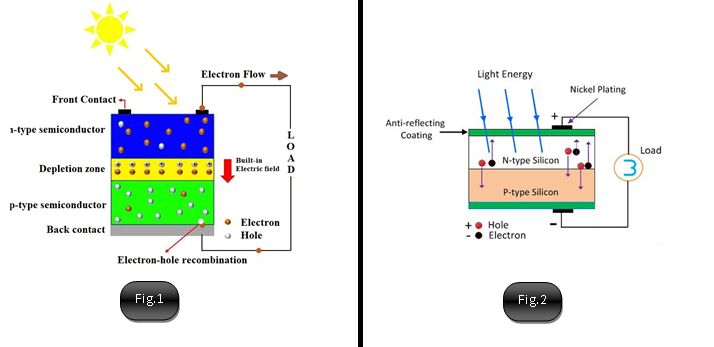Derive an equation of joint density of states.
- We know that density of states defines the number of allowed energy states per unit volume.
- To know or find the number of transitions or emissions (because that gives the no. of photons emitted) we need to know the emissions per unit volume. This can also give an idea of the power emitted.
- The number of emissions per unit volume can be found by multiplying density of states and probability of occupations.
- Concentration of electrons in conduction band is given by:
- Concentration of holes in valance band is given by:
- Suppose a radiation of energy hv is incident on an electron sitting at certain level in valence band (E1), it makes a transition to a vacant state in conduction band (E2).
- This means that absorption involves a certain energy level in valence and a corresponding vacant level in conduction band.
- Similarly, if there is an electron at certain energy level (E2’) in conduction band and it makes a transition at a vacant level (E1’) in valance band, a photon with energy hv′ is emitted.
- We can thus say that absorption and emission involve a state in valance band and conduction band.
- For a photon interaction, we have one state in valence band and one state in conduction band and so we define joint density of states that takes care of number of states for a given energy hv.
- For a fixed incident energy hv, if E2 is fixed then E1 will also be fixed.
- For a given energy hv there are several pairs of E2 – E1 and so there are number of pairs of states available for a photon of energy hv to interact and this is given by density of states.
- Since the absorption or emission takes place from the top of valence band and bottom of conduction band respectively, we can have a parabolic approximation for any level in conduction and valance band resp.
The energy of photon hv is given by:
Where, forbidden gap and reduced mass.
Substituting this value of in eq. (1) and (2),
In the above equation are constants, onlyand are variables.
Similarly,
i.e. there is 1 - 1 correspondence between and
Hence, We have,
Where, is the number if state per unit volume available for photons of energy between and to interact (either absorb or emit).
Once we found out Z (v) dv, i.e. density of states available for interaction and multiply it by probability of emission or absorption, we can obtain total number of emission or absorption per unit volume.
From equation (6),
From equation (4),
Optical joint density of states gives the number of states available for photons to interact with.
From equation (7), We have
Substituting value of
From equation (8)
This is expression for optical joint density of states.
